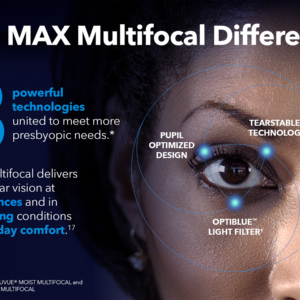June 20, 2023
While all individuals are at risk for damage from high energy visible (HEV) blue light, presbyopes may be most at risk. Light can be both beneficial and harmful to our vision and health. From a harmful perspective, UV and HEV blue light can be cumulative to our eye tissues. UV light causes damage to both the cornea and lens. These wavelengths are implicated in both cataract and pterygium. The cumulative effects begin to manifest themselves in the early presbyopic periods of our lives. Blue light, specifically, can cause damage to the retina and has been implicated in age-related macular degeneration (AMD), which manifests itself in later stages of presbyopia.
On the other hand, longer wavelengths (red-orange) provide an essential role to our overall eye and general health. Visual acuity, color perception and contrast sensitivity all benefit from these low energy level (LEV) wavelengths. General health benefits include the effect on our sleep/wake cycles, memory and mood functions, as well as our hormonal balance.
The Light Spectrum1
Dangers of UV Light
100nm-380nm
– UVC 100-280
– UVB 280-315
– UVA 315-380
UV light damages the eyes just like it damages the skin.
Daily UV exposure adds up over time and can cause irreversible damage to the eyes.
UV is a major risk factor in many severe eye diseases, including cataracts.
-Currently, surgery is the only solution to cataracts.
-20 million cataract procedures occur every year around the world.
Dangers of HEV/Blue Light
High Energy Visible light can induce and accelerate retinal cell
- damage.
- Cumulative exposure to certain wavelengths of blue light can cause damage to the retina.
- Risk factor for the development of age-related macular degeneration (AMD)
Benefits of Blue Light
Blue light (visible) benefits visual acuity and color perception
- Blue light also provides benefit to our sleep/wake cycle, mood, and memory
Cataract and AMD cases are expected to double during the next 25 years.2 This information will have a profound effect on those optometric practices that have incorporated the medical model of practice3. Simple calculations demonstrate that some practices will be consumed with post-op cataract visits and follow-up visits for AMD patients. With new developments for the treatment of both wet and dry AMD, the prospects for vision improvement in our patients is positive.
Blue Light Sources Are Everywhere
It is important to be aware of the sources of UV and HEV blue light. With respect to sunlight, we know that the season, time of day, geographic location,4 and gaze direction all have an effect on our exposure. The blue light proportion of daylight varies between 25% and 30%. On a cloudy day, up to 80% of the sun’s UV rays can pass through the clouds, which is why many individuals surprisingly get sunburned even on these cloudy days.
Besides sunlight, artificial lights can also be a source of UV and HEV/blue light. Compact fluorescent lamps may contain 25% harmful blue light. LED’s contain 35% harmful blue light (the cooler the white LED, the higher the blue proportion). With engineering mandates such as they are, up to 90% of new and replacement lights will be LED.
While serving on the Essilor Advisory Board, I had the privilege of visiting the Institut De La Vision in Paris.5 This is an important research center for eye disease. Here, the first in-vitro tests in the ophthalmic industry of subjecting live retinal cells to HEV light exposure were performed. Retinal cells from porcine (pig) eyes were subjected to 10nm bands of HEV light exposure, and it was observed that specific bands of light induced maximum retinal cell death. The blue-violet light range from 415 to 455 nm was found to be the most harmful to retinal cells. Because blue-violet light is a risk factor for the development of AMD, these findings allowed researchers to begin working on blue-light blocker coatings for spectacles.
Offer Products with Blue-light Protection
Upon returning home from the trip, I instituted a policy at the Clayton Eye Center6 that all patients should be duly informed about the hazards of blue light and presented with the option of blue-light protection on their new glasses. Since that time, many vision companies have developed superior products for our patients’ protection. It is interesting to note that compact fluorescent lamp bulbs had a peak blue-violet light at 435 nm, while LED energy peaked between 440 and 450 nm. These numbers fall within the harmful range discovered at the Institut De LA Vision.
A careful study of the effects of blue light on the human body demonstrates the need for both front-side and back-side protection from these harmful wavelengths. Front-side protection helps deflect UV light and 20% of blue-violet light, while back-side protection virtually eliminates most of the reflected harmful rays.
In conclusion, it is easy to see who most needs protection from these harmful rays. Those individuals who encounter high exposure to white/LED bulbs in offices and homes. (On a personal note, my wife insists on the whitest white lights possible in our kitchen, regardless of the above evidence). Also, frequent users of computer monitors, tablets, and smartphones need to be aware of the potential dangers. It is my belief that children wearing glasses should have blue-light protection at the youngest age. Finally, those at risk for AMD include people with a family history, current and past smokers.
References
1 The light spectrum diagram and dangers courtesy of Essilor USA
2 Source: www.nei.nih.gov
3 The medical model refers to those practitioners who spend much of their clinical time treating eye disease.
4 During six months of the year I live in Vail, Colo., at an elevation of 8,000 feet and the brightness of light is noticeable.
5 Essilor Advisory Board meeting took place in Paris during August 2013.
6 Dr. Smick was a founder of the Clayton Eye Center in 1974 and retired in 2018.






